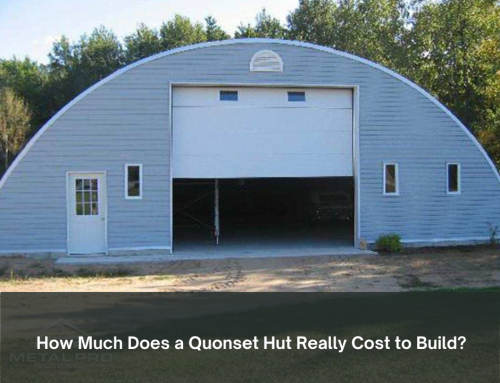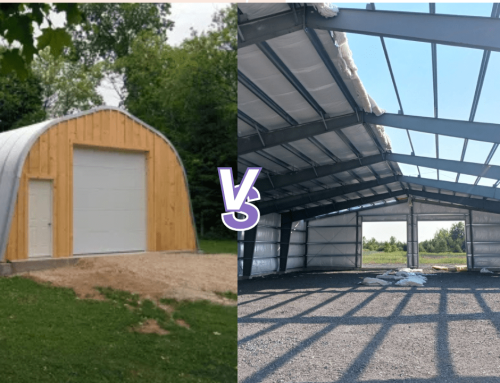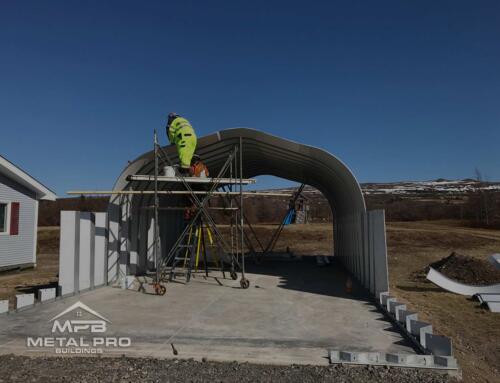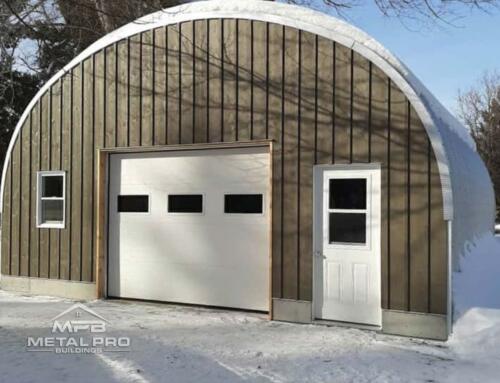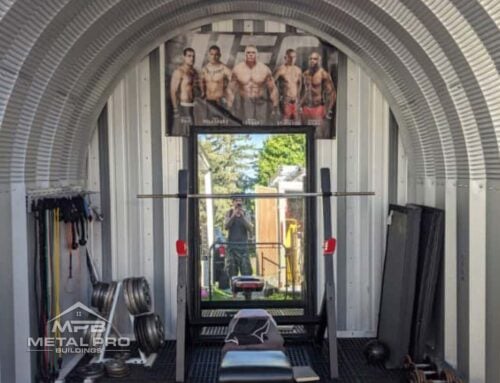When it comes to building a Quonset hut, most people focus on size, price, or design and completely overlook one detail that makes or breaks the entire structure: the steel gauge. It’s a small number with big consequences. Choose too light, and your hut might not stand up to heavy winds or snow. Go too thick, and you might overspend for strength you don’t actually need.
The truth is, gauge isn’t just about thickness it’s about durability, safety, local building codes, and long-term costs. This guide breaks it all down. In a few minutes, you’ll know exactly which steel gauge fits your needs and why it matters more than you think.
Understanding Steel Gauge Thickness and Strength
Steel gauge measures how thick a metal sheet is but unlike inches, the smaller the gauge number, the thicker the steel.
Common Gauges for Quonset Huts
- 22‑gauge: The lightest standard option, common in basic hobby or small storage huts.
- 20‑gauge: A step up offered by many manufacturers for balanced cost and durability in average conditions.
- 15‑gauge: The heaviest typical option, used in harsh environments or for heavy-duty use.
What Gauge Really Means
- Load resistance: Lower gauge (thicker steel) can better handle heavy snow, high winds, and impacts.
- Durability: Thicker steel lasts longer and resists dents, warping, and corrosion.
- Ease of handling: Lighter gauges are easier to lift and install faster assembly, less heavy machinery.
Why It Matters
Quonset huts rely on their curved shell for strength. That means the gauge of the steel itself is your structure’s skeleton. Choosing too thin means potential bending, leaking, or failing to meet building codes especially if you add windows or doors.
Basics of Steel Gauge: What the Numbers Really Mean
Steel gauge refers to the thickness of a metal sheet but it’s counterintuitive: a smaller gauge number means thicker steel, and vice versa.
How Thick Is Each Gauge?
Here’s how common steel gauges for Quonset huts compare:
| Gauge | Thickness (in) | Thickness (mm) |
|---|---|---|
| 22 | 0.0299 | 0.76 |
| 20 | 0.035 | 0.91 |
| 18 | ~0.051 | ~1.31 |
Why Lower Gauge Means Heavier Steel
The gauge system started in the 19th century. Smaller numbers show a thicker, heavier sheet . That matters because thickness affects everything from strength to cost.
Gauge vs. Thickness: A Simple Takeaway
- Thin (20–22 gauge): Lighter, easier to handle good for mild climates or smaller shelters.
- Mid (18 gauge): Stronger and more impact-resistant.
Structural Performance of Steel Gauges
Steel gauge directly influences how strong your Quonset hut will be. The lower the gauge number, the thicker and stronger the steel and that means better performance under stress.
Strength and Load-Bearing Capacity by Gauge
Lower gauge (thicker) steel can support more weight. This matters most in:
- Roof snow load:A 22-gauge panel is more prone to sagging or collapsing under heavy snow, making it less suitable for regions with harsh winter conditions.
- Wind pressure: Thicker steel resists lateral forces better, keeping the structure intact during storms or high winds.
- Dead and live loads: If you plan to hang tools, install solar panels, or mount shelving inside your hut, stronger gauge supports more without flexing.
Impact on Lifespan and Safety
Over time, thinner steel can warp, dent, or even crack especially in high-use or outdoor conditions. Thicker steel holds up better against wear and impact.
- Repeated thermal expansion and contraction
- Accidental impacts (e.g., vehicles, tools, tree branches)
- Corrosive environments when properly coated
This longevity translates into fewer repairs, safer conditions, and longer-lasting value.
Flexibility vs. Rigidity
Thinner steel (higher gauge) is more flexible. That can make it easier to install, especially for DIYers. But flexibility can also be a drawback in harsh conditions:
- It may bow under pressure or deform with heavy loads.
- It’s more susceptible to vibration-induced loosening over time.
Thicker steel offers more rigidity, which enhances both structural integrity and stability especially when building larger huts or in exposed locations.
Standard Gauges Used in Quonset Hut Construction
Manufacturers typically offer a few standard gauges (18, 20, and 22) for Quonset hut kits. Here’s when and why each is used.
Most Common Gauges by Manufacturers
- 22‑gauge is the default for most residential or light storage huts. It’s economical and easy to install .
- 20‑gauge is popular for mid-range builds, offering more strength while keeping costs manageable .
- 18‑gauge is a common upgrade for moderately harsh climates, snow, wind, or longer spans .
Industry Minimums and Raised Gauges
Manufacturers determine minimum acceptable gauges based on climate zones, building size, and intended load. For example:
- In mild climates, 22‑gauge meets the minimum for small, non-commercial huts .
- Moving into heavier snow or wind zones, customers often opt for 20‑ or 18‑gauge, either as standard or as upgrades .
Typical Use Cases by Gauge
| Gauge | Common Applications |
|---|---|
| 22‑gauge | Residential storage, garden sheds, small hobby huts in mild climates |
| 20‑gauge | Standard garages, workshops, small agricultural buildings |
| 18‑gauge | Larger garages, barns, or huts in moderate snow/wind areas |
Environmental & Location Considerations
Choosing the right steel gauge isn’t just about strength it’s also about matching your Quonset hut to local environmental challenges. Let’s explore how each factor impacts your decision and when thicker steel is essential.
Wind Load Resistance
In coastal or tornado-prone regions, wind forces can be extreme. Thicker steel (18- gauge) provides the rigidity needed to resist uplift and lateral stress. For example, building codes in hurricane zones often recommend panels no lighter than 18 gauge to secure the structure in sustained winds . For Canadian weather extremes, see how Quonset huts perform across Canada and why thicker gauges are commonly chosen.
Corrosion & Rust Protection
In humid or marine environments, steel is prone to rust even with galvanization. Thicker gauge panels have more base metal, which means even as coatings wear, there’s more resistance to corrosion. Standard 18 gauge with extra protective coatings like powder coat or paints with 70%+ Zn provide the best long-term durability .
Fire Resistance & Coatings
Steel isn’t flammable, but coatings and insulation affect fire safety. Thicker steel holds up better in high-heat scenarios and offers a sturdier base for fire-resistant layers. Some manufacturers offer Class A fire-rated coatings on 18 gauge, which reflect heat and slow fire spread .
Building Codes & Engineering Requirements
In Canada, local regulations play a pivotal role in whether your Quonset hut plan gets approved, especially the steel gauge you choose and whether you need an engineer.
Local Regulations for Steel Buildings
Canada follows the National Building Code of Canada (NBCC), adopted with provincial amendments and enforced locally . For steel structures like Quonset huts, requirements include:
- Compliance with CAN/CSA S16 (cold-formed steel structures) and S136 standards .
- Manufacturer certification to CSA A660, ensuring quality-controlled fabrication and stamped engineer-approved drawing .
- Submission of sealed structural plans (load calculations, gauge verification) for permit approval .
Gauge Choice and Permit Approval
Your chosen gauge must meet calculated load demands considering wind, snow, and seismic conditions. Building officials (AHJs) verify that:
- The steel gauge aligns with calculated load requirements.
- Stamped drawings confirm adequacy.
- If not met, your permit can be denied or delayed
To understand how gauge selection intersects with different structural options, explore Quonset vs. rigid frame steel buildings and their code compliance differences.
When You Need a Structural Engineer
You’ll likely need an engineer if:
- Your building’s location falls in a high-wind or heavy snow zone that exceeds standard kit specs.
- The hut is large or has unusual load conditions e.g., spaced far apart, tall, or with large doors/windows.
- You require sealed structural drawings for permit approval in your province or municipality .
Manufacturers certified under CSA A660 typically provide engineered drawings based on thicker gauges to satisfy local codes.
Misconceptions About Steel Gauge
Let’s dig deeper into three common misconceptions about steel gauge because knowing what doesn’t matter can be just as important as what does.
Thicker is always better?
Yes, lower gauge (thicker) steel is inherently stronger. But strength must match real needs. Using overly thick steel in mild regions or small huts can lead to:
- Unnecessary cost and weight, increasing shipping and labor.
- Assembly challenges each arch becomes heavier and harder to maneuver, as seen when arch sections weigh ~240 lb each .
Engineering principles show that design elements like arch curvature and bracing can often compensate. A properly engineered 18‑ or 20‑gauge hut can offer superior performance compared to poorly designed alternatives.
Heavier gauge = better insulation?
Many assume thicker steel also insulates better. Not true.
- Steel conducts heat, no matter the thickness. Thermal performance depends on insulation layers not the gauge .
- Even thin-gauge huts can stay comfortable when properly insulated. Radiant-barrier insulation (e.g., BlueTex™) reflects up to 97% of radiant heat, dramatically reducing interior temperature swings .
Pick your gauge for structure. Pick insulation materials batten, spray foam, radiant barrier for thermal comfort.
How design and engineering sometimes outweigh gauge choice
Steel gauge provides raw strength but structural performance comes down to design:
- Arch curvature and bracing: Proper bracing (even in 18 gauge steel) provides stability and resistance to lateral buckling .
- Connection quality: Tight bolting and correct tension help thinner steel perform like thicker steel .
Thermal bridge details: Without good design, even thick steel framing can hurt insulation studies show thermal bridges can reduce energy performance by up to 74% if unaddressed .
Conclusion
Choosing the right steel gauge for your Quonset hut comes down to matching your needs with your environment. Thicker steel isn’t always better; it’s about using the right gauge for your climate, building size, and purpose. With proper design, insulation, and reinforcements, you can build a strong, long-lasting structure without overspending.
Get Started Today
Build smarter with steel that’s designed to last. Contact Metal Pro™ Buildings now for a free quote and expert advice tailored to your project’s size, location, and use.


